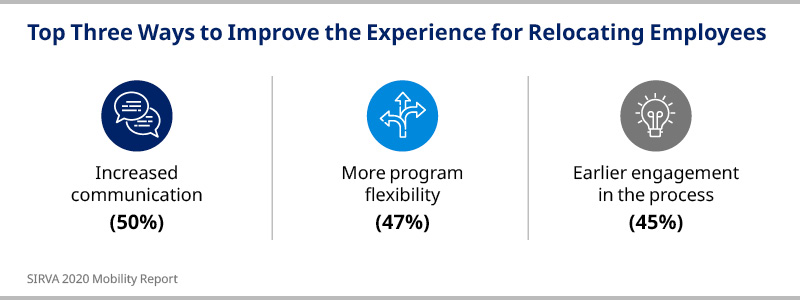Blog
Striking a Balance: Delivering a Positive Mobility Experience and Controlling Costs
The battle with COVID-19 has proven to be a long and weary one with different virus strains surfacing in numerous countries around the globe. Economies continue to bear the brunt of the pandemic and organisations struggle to navigate these challenging times. Prudent spending and cost control have thus been at the forefront for organisations worldwide, but not at the expense of the employee mobility experience.
Previously, our white paper, Controlling the Costs of Mobility, explored the key influencers driving relocation costs and how to manage those costs. We now shift our focus to how companies can deliver a positive employee experience while still managing the mobility spend. For many programmes, the concept of managing costs equates to a reduction in the nature or level of support that is provided, which may negatively affect the mobility experience; however, reducing costs does not need to have this outcome.
This blog post examines why the employee experience should be a main focus for organisations and highlights some best practices from a reputable global brand as they shed light on striking a delicate balance between the employee mobility experience and cost control.
Why is a Positive Employee Experience Important?
Today, as we continue to navigate the pandemic, we are encountering a new reality that requires rethinking global mobility. Employees’ changing expectations and the possibilities of flexible working arrangements are leading companies to reassess and reshape mobility.
Mobility opportunities are a way to attract and retain talent. The design and delivery of a mobility programme should reflect competitive, best-in-class practices that support the needs of both the organisation and employee. Organisations are seeing the significance of a positive and consistent employee experience against the backdrop of operating in a highly competitive global economy.
Some approaches that organisations are undertaking to bridge talent gaps via mobility programmes include enhancing communication amongst all stakeholders, building more flexibility into their programmes to support employee needs, and planning earlier within the relocation lifecycle for ongoing and post-relocation career development.

Where cost reduction was not indicated as a requirement for programme owners, organisations noted that attracting and retaining existing talent was more important than cost reduction or cost containment (41%) or that costs were already at an acceptable level (31%). It is a positive sign that organisations are prioritising new and existing talent, and recruiting and talent development, over cost. They are also recognising that slashing costs is not the way to attract and retain the global talent with the right skills needed for their organisation to be successful. Having the right person, in the right role, at the right time is still critical to business success, and mobility plays a significant role in supporting this priority.

SIRVA’s Mobility Report supports this, with 73% of respondents rating deploying talent as “extremely important” or “very important” to the overall success of their organisation.
Case Study: How Hewlett Packard Enterprise (HPE) Achieves Positive Employee Experience While Controlling Costs
HPE is a global, edge-to-cloud Platform-as-a-Service company with over 60,000 employees worldwide. As a company with an extensive global footprint, they understand that their people are their biggest asset and employee experience is an area in which they are unwilling to compromise. “We always learn important lessons from world events”, said Kerwin Guillermo, Global Head of Employee Mobility, Hewlett Packard Enterprise. “COVID-19 has presented us with an uncommon workforce environment, where it is more critical than ever to retain our talent and attract new and additional talent. At HPE, we respect and honour our employees’ needs, and because this level of commitment keeps employees engaged, it leads to success in our business objectives, too.” HPE has long been enjoying success with their mobility programme without breaking the bank. Here’s a look at how they do things.
Differentiated Investments A Key Driver to HPE’s Global Mobility Programme
HPE’s mobility programme hinges on the concept of “differentiated investments” where managers are empowered to design relocation packages based on business strategy and the needs of the employees. Benefits are segmented into Basic, Moderate and Enhanced depending on the move strategy, job level and family size.
Example: An HPE employee whose wife was pregnant was up for relocation. He raised his concerns to his manager and provisions were made during package design to include Household Goods White Glove services to help the family settle in quickly so the employee was able to focus on his new role in the destination location.
|
Learning Points:
|
Pay for Performance Helps Retain Talent & Control Costs
HPE has successfully designed a Pay for Performance programme that ties incentive to relocation performance. An incentive will be paid according to an employee’s achievement toward the goals set for the assignment or transfer. This not only promotes the manager’s and employee’s engagement throughout the assignment period, but drives the employee’s achievement toward the assignment goal that eventually brings savings to the business.
Example: Goals are established before the employee starts his/her new role. SIRVA helps HPE document those goals and performance reviews are conducted throughout the duration of the assignment. If goals are met, employees get to look forward to a bonus pay-out at the end of the assignment, or 12 months after transfers.
Learning Points:
|
A Well-Rounded Engagement Programme is Key to A Positive Employee Experience
At HPE, employees are actively involved in discussions with their managers at every step of the relocation process. Managers are tasked to clearly communicate the “why” of mobility to employees. Every move is seen as an opportunity for growth of the employee, a further investment in their careers, a chance to develop new teams and be exposed to new cultures, and the possibility of returning to be a new leader.
Example: In addition to engaging in frequent conversations with the job managers, employees have full access to HPE’s content library consisting of a wide range of videos. These videos serve to motivate and educate employees as they are equipped with the tools and information to help them reach their goals, make better decisions, and tackle complex work situations.
Learning Points:
|
While cost rationalisation remains a top priority for mobility stakeholders, it should never come at the expense of a positive employee experience. HPE has demonstrated the strategies they have undertaken to do that without incurring additional costs.
Please contact concierge@sirva.com to find out how we can help you balance your employees’ experience and cost control in your mobility programme.

